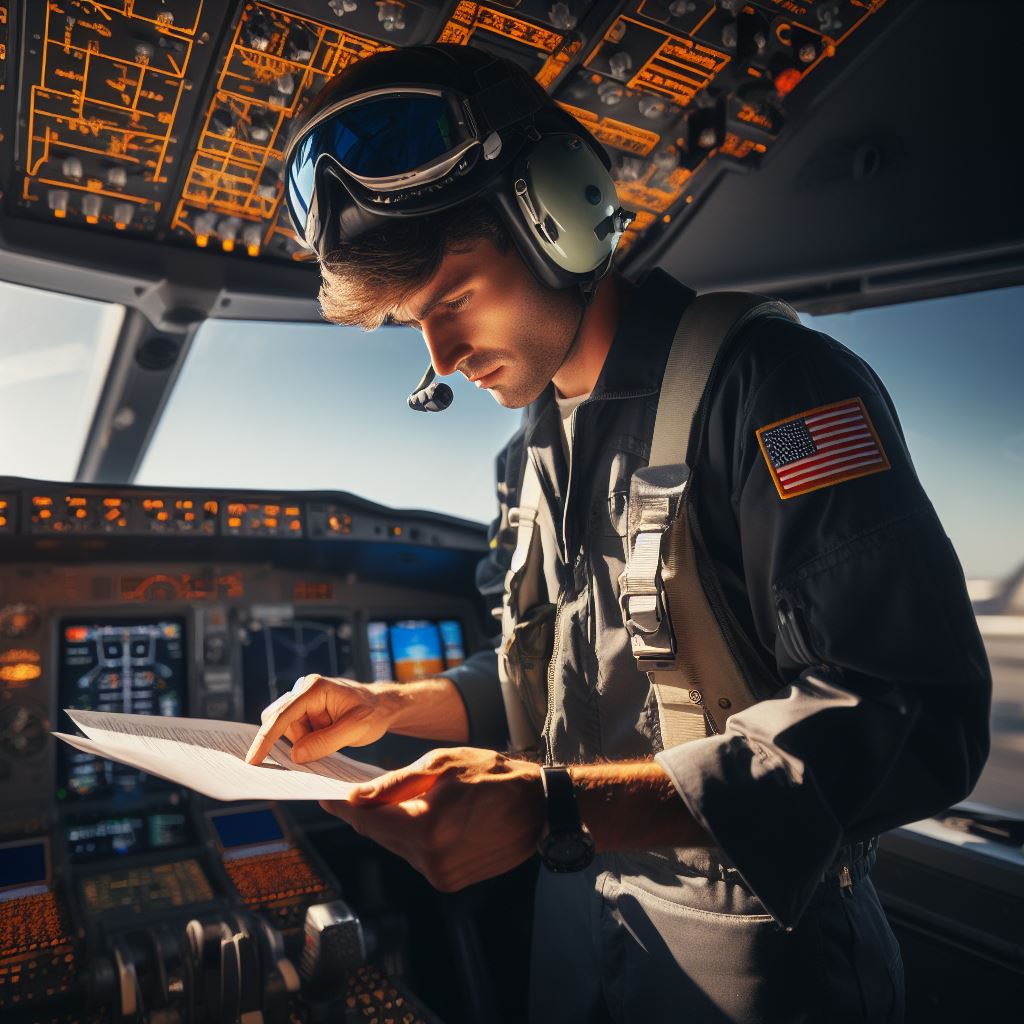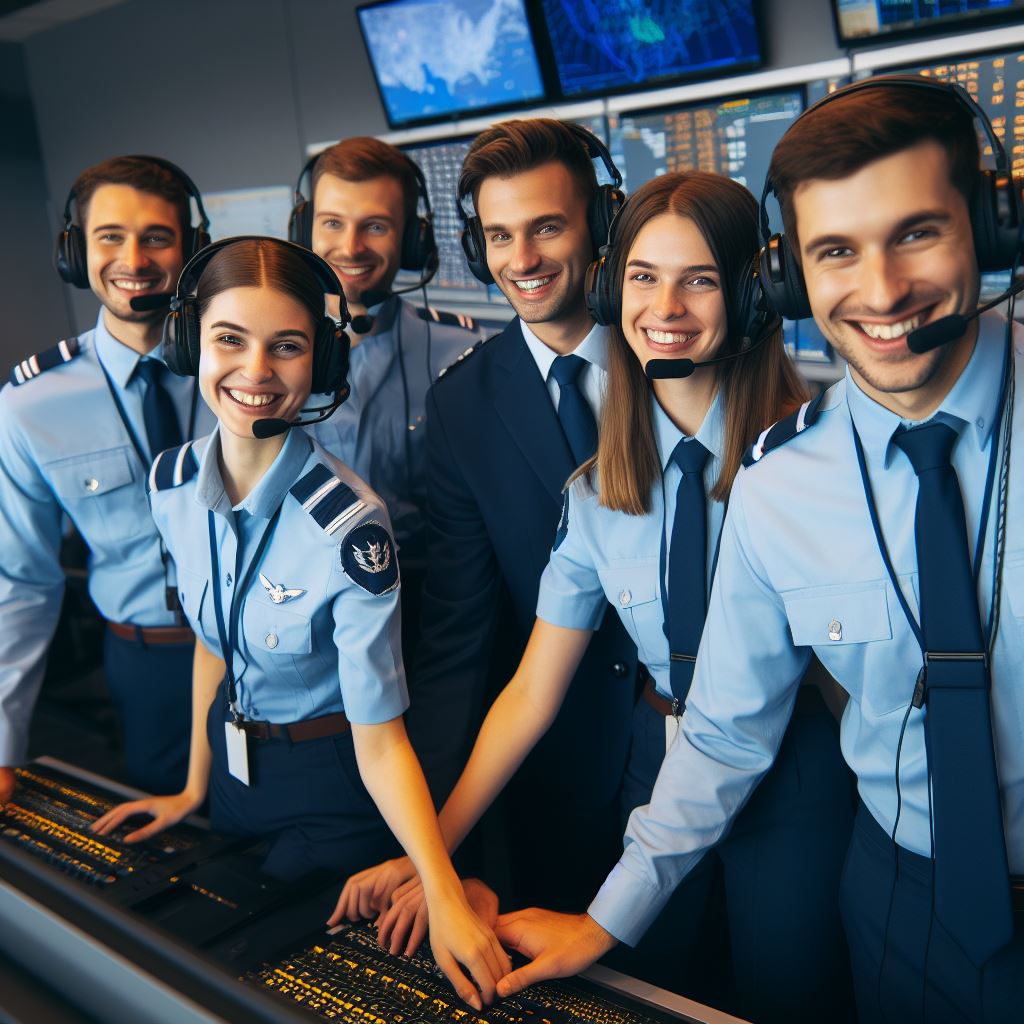Introduction
Safety protocols and procedures are crucial in air traffic control to ensure safe and efficient air travel. U.S. air traffic control plays a pivotal role in maintaining this safety.
Air traffic control relies on meticulous safety protocols. Stringent procedures ensure the safe and efficient movement of aircraft, preventing potential hazards.
Regular training enhances controllers’ ability to respond to diverse situations, prioritizing passenger and aviation safety.
Precision in communication and adherence to protocols are paramount in averting accidents and maintaining air travel’s stellar safety record.
The robust implementation of safety measures underscores the indispensable role of air traffic control in securing the skies.
Committed to constant improvement, controllers remain vigilant, emphasizing safety as the cornerstone of air travel operations.
U.S. air traffic control plays a pivotal role in ensuring safe and efficient air travel nationwide.
Controllers manage airspace, direct flights, and coordinate landings, safeguarding passengers and facilitating smooth air operations.
Their precision and real-time decision-making prevent collisions, reduce delays, and optimize route efficiency, contributing to the overall safety and reliability of the aviation system.
This critical function extends beyond routine operations, as controllers swiftly respond to emergencies, ensuring swift and secure resolutions.
Through continuous monitoring and communication, air traffic control exemplifies the proactive commitment to passenger safety and the seamless functioning of the U.S. aviation network, underscoring its indispensable role in the nation’s airspace management.
Overview of U.S. Air Traffic Control
Primary Objective of U.S. Air Traffic Control
The primary objective of U.S. air traffic control is to ensure the safe, orderly, and efficient flow of air traffic.
It involves managing the movement of aircraft to prevent collisions and minimize delays.
Responsibility of Air Traffic Controllers
- Air traffic controllers have the crucial responsibility of managing and directing air traffic.
- They monitor aircraft using radar, communicate with pilots, and provide instructions for takeoff, landing, and during flight.
- Controllers need to make quick decisions and adapt to changing conditions to maintain safety.
- They coordinate and prioritize aircraft movements to maintain optimal spacing and avoid congestion.
- Air traffic controllers also provide pilots with weather information and assist in emergencies.
Role of Federal Aviation Administration (FAA)
The Federal Aviation Administration (FAA) plays a crucial role in overseeing air traffic control operations in the United States.
- The FAA is responsible for setting and enforcing safety protocols and procedures in air traffic control.
- It develops and updates regulations to ensure the highest level of safety in the National Airspace System (NAS).
- The FAA trains and certifies air traffic controllers to meet the required standards.
- It conducts regular assessments and inspections to monitor compliance with safety regulations.
- The agency also collaborates with other aviation organizations to enhance air traffic management technology.
Air traffic control is a complex and vital component of the aviation industry.
It requires highly skilled professionals and efficient protocols to ensure the safety of passengers, crew, and aircraft.
The primary objective of U.S. air traffic control is to prevent accidents and incidents by effectively managing air traffic.
Air traffic controllers are at the heart of this operation.
These professionals perform under high pressure, requiring excellent communication, decision-making, and problem-solving skills.
The Federal Aviation Administration (FAA) plays a critical role in overseeing air traffic control operations.
Transform Your Career Today
Unlock a personalized career strategy that drives real results. Get tailored advice and a roadmap designed just for you.
Start NowThe agency sets and enforces regulations to maintain the highest level of safety in the National Airspace System.
The FAA ensures that air traffic controllers are properly trained, and collaborates with industry partners to improve technology and procedures.
Safety is paramount in air traffic control. Controllers must constantly assess and adapt to changing conditions, working collaboratively to prevent collisions and minimize delays.
U.S. air traffic control aims to ensure the safe, orderly, and efficient flow of air traffic.
Air traffic controllers and the FAA play crucial roles in achieving this objective.Their expertise, dedication, and adherence to safety protocols are essential for the smooth operation of the aviation industry.
Read: Flight Schools in the USA: Choosing the Right One
Safety Management Systems
Safety Management Systems (SMS) play a crucial role in ensuring the safety of air traffic control operations.
By implementing effective SMS, potential risks can be identified and mitigated, creating a safer aviation industry.
Safety Management Systems (SMS) and their Significance in Air Traffic Control
SMS is a systematic approach that integrates safety policies, risk management, and safety assurance processes to enhance safety in air traffic control.
It aims to proactively identify and mitigate potential risks, ensuring the safety of aviation operations and minimizing accidents.
The significance of SMS in air traffic control is immense.
It provides a structured framework for managing safety, promoting a culture of safety among aviation personnel, and fostering continuous improvement.
SMS contributes to reducing the chances of human errors, equipment failures, and operational risks.
Moreover, SMS instills confidence in the public by assuring them that air traffic control authorities are actively working to enhance safety measures.
It increases the efficiency and effectiveness of operations and significantly reduces the likelihood of accidents, incidents, and disruptions in the aviation industry.
Key Components of SMS, including Safety Policies, Risk Management, and Safety Assurance
Safety Policies
Safety policies establish a clear direction and commitment towards safety.
They define responsibilities, roles, and accountabilities of aviation personnel, ensuring a shared understanding of safety objectives and expectations.
Safety policies demonstrate an organization’s commitment to safety and provide guidelines for decision-making processes.
Risk Management
Risk management is an essential component of SMS. It involves identifying, assessing, and analyzing risks associated with air traffic control operations.
By systematically evaluating potential hazards and their consequences, risk management enables the development of effective strategies to mitigate risks.
Transform Your Career Today
Unlock a personalized career strategy that drives real results. Get tailored advice and a roadmap designed just for you.
Start NowIt helps prioritize risks and allocate appropriate resources to minimize their impact.
Safety Assurance
Safety assurance ensures that the implemented safety measures are operating effectively.
It involves conducting audits, inspections, and safety performance monitoring to identify any deficiencies and non-compliance.
Safety assurance measures include safety data collection, analysis, and feedback mechanisms to continuously improve safety performance.
How SMS Helps Identify Potential Risks and Develop Strategies to Mitigate Them
SMS helps air traffic control organizations identify potential risks by establishing a proactive safety culture.
By conducting hazard identification processes, including safety reporting systems and safety surveys, potential risks are acknowledged and reported.
This allows organizations to take prompt action and develop strategies to mitigate these risks.
Once potential risks are identified, SMS facilitates the development and implementation of risk mitigation strategies.
This may include changes in procedures, improvements in training programs, enhancements in equipment and technology, or modifications in organizational practices.
By monitoring and analyzing safety data, SMS ensures the effectiveness of implemented strategies and continually improves safety performance.
Furthermore, SMS encourages open and transparent communication among aviation personnel, enabling the identification of emerging risks and the development of proactive approaches to address them.
By fostering a safety-oriented work environment, SMS establishes a robust system that prevents accidents, reduces operational errors, and enhances overall air traffic control safety.
In fact, Safety Management Systems (SMS) are of paramount importance in air traffic control.
Through its key components of safety policies, risk management, and safety assurance, SMS helps identify potential risks and develop strategies to mitigate them.
By implementing effective SMS, the aviation industry ensures the safety of operations and creates a culture of continuous improvement in safety management.
Read: Flight Schools in the USA: Choosing the Right One
Training and Certification of Air Traffic Controllers
In order to ensure the safety and efficiency of air traffic control in the United States, air traffic controllers undergo a rigorous training program that prepares them for the specialized knowledge and skills required for the job.
The certification process and ongoing professional development requirements further enhance their expertise.
Rigorous Training Program
- Intense theoretical and practical training is provided to aspiring air traffic controllers.
- Trainees must complete a comprehensive curriculum that covers various aspects of air traffic control.
- Subjects include aviation regulations, communication procedures, weather patterns, and aircraft performance characteristics.
- Simulators are extensively used to provide realistic training scenarios to the trainees.
- Trainees are exposed to various complex air traffic situations to develop their decision-making skills.
- The training program includes extensive practice in managing high-stress situations and multitasking.
- Trainees also learn how to use advanced technology and computer systems utilized in air traffic control.
Specialized Knowledge and Skills
- Air traffic controllers need to possess exceptional attention to detail and strong analytical skills.
- They must have the ability to think quickly and make accurate decisions in fast-paced environments.
- Excellent communication skills are crucial to effectively coordinate with pilots and other controllers.
- Controllers should possess a deep understanding of aviation terminology and phraseology.
- They must be able to interpret radar displays, charts, and other technical information.
- Controllers should also have a thorough knowledge of airspace rules and regulations.
- Continuous learning is necessary to stay updated with technological advancements and changes in procedures.
Certification Process and Ongoing Professional Development
- After completing the training program, air traffic controllers must obtain certification from the Federal Aviation Administration (FAA).
- They need to pass a comprehensive examination that tests their knowledge and practical skills.
- Controllers who meet the FAA’s standards receive their Air Traffic Control Tower Operator certification.
- Once certified, controllers go through a probationary period where they gain on-the-job experience.
- Controllers are required to undergo regular performance evaluations and medical examinations.
- Continuing education and professional development programs are essential for controllers to maintain their skills.
- Controllers attend workshops, seminars, and courses to enhance their knowledge and stay updated.
- They also participate in simulation exercises and refresher training on a regular basis.
Basically, the training and certification process for air traffic controllers in the United States is rigorous and comprehensive, ensuring that they possess the necessary specialized knowledge and skills to perform their critical job responsibilities.
Ongoing professional development requirements further enhance their expertise, enabling them to effectively and safely manage air traffic control operations.
Transform Your Career Today
Unlock a personalized career strategy that drives real results. Get tailored advice and a roadmap designed just for you.
Start NowRead: The Path to Becoming a Commercial Pilot in the USA

Communication and Coordination Procedures
In the world of air traffic control, effective communication and coordination are of utmost importance.
The smooth functioning of the air traffic control system heavily relies on the seamless exchange of information between air traffic controllers.
The Importance of Effective Communication and Coordination Among Air Traffic Controllers
- Ensuring Safety: Effective communication and coordination directly impact the safety of aircraft and passengers. These procedures minimize the possibility of accidents and ensure efficient air traffic management.
- Avoiding Confusion: Through clear and concise communication, air traffic controllers prevent misunderstandings and confusion among pilots, reducing the likelihood of errors that could have grave consequences.
- Handling Potential Threats: Quick and accurate dissemination of information allows controllers to promptly address potential security threats and take immediate actions to ensure the safety of the airspace.
- Collaborative Decision Making: Effective communication facilitates collaboration and decision-making among air traffic controllers, enabling them to work together towards a common goal of safe and efficient air traffic management.
Standardized Phraseology and Protocols in Air Traffic Control Communication
- ICAO Phraseology: The International Civil Aviation Organization (ICAO) has established standardized phraseology for air traffic control communication. This ensures a common language across the globe, minimizing misunderstandings caused by language barriers.
- Readback and Hearback: Controllers use readback and hearback techniques to confirm that pilots received and understood their instructions accurately. This two-way communication ensures comprehension and reduces the chance of errors.
- Clearances and Instructions: Standardized protocols govern the issuance of clearances and instructions to pilots. These protocols define the order, structure, and format of communication, minimizing ambiguity and enhancing safety.
- Phonetic Alphabet and Numbers: Air traffic controllers use the phonetic alphabet (Alpha, Bravo, Charlie, etc.) and standardized number pronunciation to ensure clarity when communicating letters and digits.
Use of Advanced Technology and Equipment for Improved Communication
- Data Communication Systems: Advanced technology has introduced data communication systems that allow controllers to transmit information digitally, reducing the reliance on voice communication and increasing efficiency.
- Radar Systems: Modern radar systems provide real-time data on aircraft positions, aiding controllers in maintaining safe separation and facilitating effective communication regarding aircraft movement.
- Automated Weather Systems: Air traffic controllers have access to automated weather systems that provide up-to-date and accurate weather information. This data helps controllers make informed decisions and relay important information to pilots.
- Digital Recording Systems: The use of digital recording systems allows for the effective analysis of communication in case of incidents or disputes. This technology aids in improving procedures and resolving issues.
- Collaborative Decision-Making Tools: Advanced communication tools enable collaborative decision-making among controllers, pilots, and other stakeholders, facilitating efficient traffic flow management and reducing delays.
Effective communication and coordination are fundamental aspects of air traffic control.
Through standardized phraseology, protocols, and the use of advanced technology, air traffic controllers ensure the safety and efficiency of the skies.
By continuously improving communication procedures, the aviation industry strives to enhance the overall air traffic management system for a safer and more streamlined experience.
Read: Earning Potential: Salaries of US-based Pilots
Emergency Response Protocols
Emergency response protocols in U.S. air traffic control
During an emergency in air traffic control, strict protocols and procedures are followed to ensure the safety of aircraft, passengers, and the surrounding areas.
These emergency response protocols are designed to minimize risks and provide efficient handling of critical situations.
Procedures for handling emergency situations such as aircraft malfunctions, severe weather conditions, or security threats
In the event of an aircraft malfunction, air traffic controllers play a crucial role in ensuring the safe landing or diversion of the affected aircraft.
They immediately notify the appropriate authorities and work closely with the pilots to guide them through the necessary steps.
Controllers provide vital information on available runways and help prioritize landing or takeoff slots to avoid any potential danger.
Severe weather conditions pose significant challenges in air traffic control.
When faced with such situations, controllers closely monitor weather reports and communicate the changing conditions to pilots.
They advise pilots on the safest routes and altitudes, taking into consideration turbulence, lightning, and other weather-related hazards.
This collaborative effort aims to keep the aircraft on a secure path and prevent any unforeseen dangers.
Security threats are a growing concern in aviation. Air traffic controllers receive specialized training to handle such emergencies effectively.
When a security threat is identified, controllers initiate security protocols and implement measures to ensure the safety of all aircraft within their jurisdiction.
They work closely with relevant authorities, such as law enforcement agencies and the military, to coordinate a swift and appropriate response.
Coordination among air traffic controllers, pilots, and other relevant authorities during emergencies
Effective coordination among air traffic controllers, pilots, and other authorities is essential during emergency situations.
Transform Your Career Today
Unlock a personalized career strategy that drives real results. Get tailored advice and a roadmap designed just for you.
Start NowControllers act as the central point of communication, relaying crucial information between all parties involved.
They maintain constant communication with pilots, providing updates, instructions, and guidance.
Additionally, they collaborate with relevant authorities to ensure a smooth flow of information and resources, allowing for prompt decision-making during emergencies.
Regular training and drills are conducted to keep air traffic controllers well-prepared for emergency situations.
These exercises simulate various scenarios, allowing controllers to practice their responses and enhance their decision-making skills.
This preparation ensures controllers can manage unexpected events confidently and efficiently, minimizing risks and maximizing safety.
Furthermore, technological advancements have significantly improved emergency response capabilities in air traffic control.
Real-time data and advanced radar systems enable controllers to detect potential emergencies early and respond promptly.
Additionally, automated systems aid in analyzing complex situations, providing controllers with critical information necessary for effective decision-making.
In general , U.S. air traffic control has well-established emergency response protocols in place to handle a range of emergencies, including aircraft malfunctions, severe weather conditions, and security threats.
These protocols emphasize the importance of coordination among air traffic controllers, pilots, and other relevant authorities.
With rigorous training, advanced technology, and effective communication, the aviation industry continues to prioritize safety and security in emergency situations.
Find Out More: The Role of Technology in Modern Train Conduction
Learn More: How to Become a Train Conductor: Step-by-Step Guide
Maintenance and Inspection Procedures
In order to ensure the safety and reliability of air traffic control systems, meticulous maintenance and inspection protocols are followed.
This section will delve into the various procedures involved in maintaining and inspecting air traffic control equipment and systems.
Maintenance and Inspection Protocols
The maintenance and inspection protocols for air traffic control equipment and systems are robust and comprehensive.
These protocols involve regular inspections, preventive maintenance, and repair processes.
1. Regular Inspections
Regular inspections are carried out to identify any potential issues or malfunctions in the air traffic control equipment and systems.
These inspections are performed by qualified technicians who thoroughly examine the equipment to ensure its proper functionality.
Transform Your Career Today
Unlock a personalized career strategy that drives real results. Get tailored advice and a roadmap designed just for you.
Start Now2. Preventive Maintenance
Preventive maintenance plays a crucial role in maintaining the functionality of air traffic control equipment.
It involves scheduled checks and routine servicing to preemptively address any potential problems and ensure smooth operation.
3. Repair Processes
If any issues or malfunctions are identified during inspections or through reports, the repair processes are initiated.
Experienced technicians are responsible for diagnosing the problem and carrying out the necessary repairs to restore the functionality of the equipment.
Role of Quality Control Measures
Quality control measures are of paramount importance in maintaining the safety and reliability of air traffic control systems.
These measures are implemented throughout the maintenance and inspection processes.
1. Equipment Calibration
Regular calibration of air traffic control equipment is conducted to ensure accurate performance.
This involves adjusting and aligning the equipment to meet the required standards and specifications.
2. Performance Testing
Performance testing is essential to verify the proper functioning of air traffic control systems.
Various tests are conducted to evaluate the performance, accuracy, and responsiveness of the equipment, ensuring it meets the necessary standards.
3. Documentation and Reporting
Thorough documentation and reporting are maintained throughout the maintenance and inspection processes.
Any findings, repairs, or adjustments made during inspections are recorded to provide a comprehensive history of the equipment’s maintenance.
4. Compliance with Regulations
Strict adherence to regulations and guidelines set by aviation authorities is a vital aspect of maintaining the safety and reliability of air traffic control systems.
The quality control measures ensure compliance with these regulations.
Effective maintenance and inspection protocols, coupled with rigorous quality control measures, play a crucial role in ensuring the safety and reliability of air traffic control systems.
Regular inspections, preventive maintenance, and repair processes are fundamental in identifying and addressing any issues promptly.
The implementation of quality control measures, such as equipment calibration, performance testing, and documentation, further enhances the safety and functionality of the equipment.
Adherence to regulations and guidelines completes the comprehensive approach to maintaining the integrity of air traffic control systems.
By following these maintenance and inspection procedures, air traffic control authorities can uphold the highest levels of safety and reliability, allowing for the smooth and efficient functioning of the aviation industry.
Conclusion
Safety protocols and procedures in U.S. air traffic control play a crucial role in ensuring the safety of air travel.
Transform Your Career Today
Unlock a personalized career strategy that drives real results. Get tailored advice and a roadmap designed just for you.
Start NowThe implementation of these protocols is vital as it prevents potential accidents and ensures the smooth flow of air traffic.
Continuous efforts are being made to improve safety standards and enhance air travel safety.
This includes the implementation of advanced technologies, regular training programs, and strict regulatory oversight.
These measures aim to minimize human errors and ensure the highest level of safety.
It is important for readers to appreciate the significance of air traffic control systems and support a culture of safety in aviation.
By understanding the importance of following protocols and procedures, passengers can have peace of mind knowing that their safety is a top priority in the aviation industry.
To support a culture of safety, readers can actively participate in promoting safe practices.
This can be done by reporting any suspicious behavior, following instructions from air traffic controllers, and being mindful of safety regulations when traveling.
Together, we can contribute to enhancing the safety of air travel for everyone.
It is imperative that we acknowledge the efforts made by air traffic controllers and technicians who work tirelessly to ensure our safety in the skies.
By appreciating their dedication and supporting ongoing safety improvements, we can help maintain the high level of safety standards in U.S. air traffic control.
Safety protocols and procedures play a vital role in U.S. air traffic control. Let us all recognize the importance of these measures and work together to create a safer and more secure environment for air travel.




